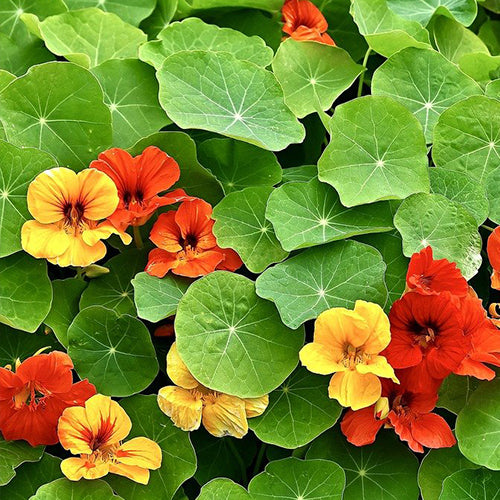
How To Grow Nasturtium From Seeds - Tropaeolum majus
Share
Are you looking for a vibrant and versatile plant to add to your garden? Look no further than the Nasturtium plant! With its stunning flowers and numerous health benefits, this plant is a must-have for any gardening enthusiast.
In this blog post, we will explore the fascinating world of the Nasturtium plant and discover why it deserves a special place in your garden.
What makes the Nasturtium plant unique?
The Nasturtium plant, scientifically known as Tropaeolum majus, is a beautiful flowering plant native to South America. It is renowned for its vibrant and eye-catching flowers that come in a variety of colors, including shades of red, orange, and yellow. These flowers not only add a pop of color to your garden but also attract pollinators like bees and butterflies, making it a valuable addition to any ecosystem.
Benefits of the Nasturtium plant
Did you know that the Nasturtium plant offers more than just visual appeal? It also provides several health benefits that make it a valuable addition to your diet.
- Health benefits: The leaves, flowers, and seeds of the Nasturtium plant are all edible and packed with nutrients. They are rich in vitamin C, iron, and antioxidants, which can boost your immune system and promote overall well-being. Nasturtium plant has antimicrobial properties, which can help fight against certain bacteria and fungi. Some studies even suggest that it may have anticancer effects, although more research is needed to confirm these claims.
- Edible Delights: Nasturtium flowers and leaves are not only visually appealing but also have a peppery, tangy flavor that adds a unique twist to salads, sandwiches, and other dishes.
- Attractive Garden Addition: Nasturtium plants feature vibrant flowers in shades of orange, yellow, and red, making them a beautiful addition to any garden or balcony.
- Natural Pest Repellent: Nasturtium plants release a strong scent that repels pests like aphids, whiteflies, and squash bugs, protecting your other plants from damage.
- Medicinal Uses: Nasturtium leaves and flowers have been used in traditional medicine for their antibacterial and anti-inflammatory properties. They can be made into teas, tinctures, or used topically.
How to grow and care for the Nasturtium plant
Now that you're convinced of the Nasturtium plant's beauty and benefits, let's talk about how to grow and care for it. The good news is that Nasturtiums are relatively easy to grow, even for beginners. They thrive in well-drained soil and prefer full sun or partial shade.
You can start growing Nasturtiums from seeds, which are readily available at garden centers. Simply sow the seeds directly into the soil after the last frost date. Make sure to space them about 10 to 12 inches apart to allow for proper growth. Water the plants regularly, but be careful not to overwater them, as Nasturtiums prefer slightly dry conditions.
One of the best things about Nasturtiums is their versatility. They can be grown in containers, hanging baskets, or even as ground cover. Their trailing habit makes them perfect for cascading down walls or trellises, adding a touch of elegance to any garden.
Incorporating Nasturtiums into your culinary adventures
Not only are Nasturtiums visually appealing and easy to grow, but they also offer a unique flavor that can elevate your culinary creations. The flowers have a slightly peppery taste, similar to watercress, which makes them a delightful addition to salads, sandwiches, and even desserts.
The leaves and seeds of the Nasturtium plant are also edible and can be used to create flavorful pestos, sauces, and marinades. Their vibrant colors can add a touch of elegance to any dish, making them a favorite among creative chefs and home cooks alike.
About Nasturtium Seeds
Nasturtium seeds are the small, round seeds of the Nasturtium plant, scientifically known as Tropaeolum majus. These seeds are commonly used for culinary and medicinal purposes due to their unique flavor and health benefits.
How to Plant Nasturtium Seeds?
Planting Nasturtium seeds is a simple process that can be done in a few easy steps:
- Choose a sunny location in your garden with well-drained soil.
- Prepare the soil by removing any weeds and loosening it with a garden fork.
- Sow the seeds directly into the soil, spacing them about 10 inches apart.
- Cover the seeds with a thin layer of soil and water gently.
- Keep the soil moist but not waterlogged.
- Within a few weeks, the seeds will germinate, and you'll see the beautiful Nasturtium plants growing.
Tips for Caring for Nasturtium Plants
To ensure healthy growth and abundant blooms, consider the following tips:
- Watering: Nasturtium plants prefer moderate watering. Avoid overwatering, as it can lead to root rot.
- Deadheading: Regularly remove faded flowers to encourage continuous blooming.
- Fertilization: Nasturtiums are not heavy feeders. A well-balanced, organic fertilizer once a month is sufficient.
- Support: If you're growing climbing or trailing varieties, provide support like trellises or stakes for them to climb.
- Pest Control: While Nasturtium plants repel many pests, occasionally, they can attract caterpillars or black aphids. Handpick or use organic pest control methods if necessary.
Conclusion
The Nasturtium plant is a true gem in the world of gardening. With its stunning flowers, health benefits, and culinary versatility, it is a plant that deserves a special place in your garden. Whether you're a seasoned gardener or just starting, the Nasturtium plant is a must-have for anyone looking to add beauty, flavor, and a touch of elegance to their outdoor space. So, why wait? Start growing your own Nasturtiums today and experience the wonders they have to offer!

